General Apple and Mac desktop news is covered in Mac News Review. iPad, iPod, iPhone, and
Apple TV news is covered in iOS News
Review. All prices are in US dollars unless otherwise noted.
Retina MacBook Pro News & Opinion
15" MacBook Pro News & Opinion
13" MacBook Pro News & Opinion
Rumor Roundup
Apple Updates
Tech Trends
Retina MacBook Pro News & Opinion
Retina MacBook Pro with Can Run 3 External Displays
at Once
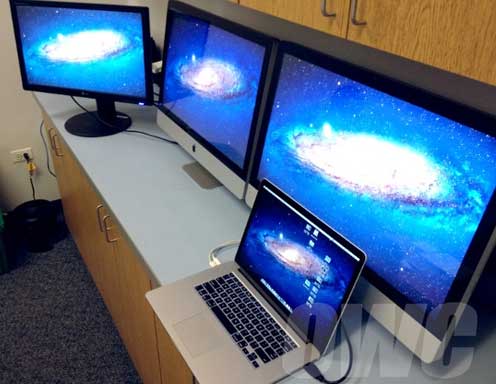
Retina MacBook Pro running 3 external displays.
OWC blogger Mike H. reports that including its built-in Retina
display, the 2012
MacBook Pro with Retina Display can run four displays at their
native resolution with its two Thunderbolt ports and an integrated HDMI
port.
- Retina on laptop @ best for Retina
- iMac used as a display @ 2560 x 1440 via Thunderbolt
- iMac used as a display @ 2560 x 1440 via
Thunderbolt/DisplayPort
- LG monitor @ 1920 x 1200 via HDMI
Mike says moving images and media didn't create any lag, and they
were able to play video on all four displays simultaneously.
Link: MacBook Pro 15"
with Retina Display Can Run 3 External Displays
Retina MacBook Pro the Fastest Mac Ever Tested by
Macworld Labs
Macworld's Roman Loyola says that the new MacBook Pro with Retina
Display, Apple directs attention back to the Mac, the "RetinaBook"
being a groundbreaking release that will force us to rethink the way we
interact with a laptop - how we view and work with content, and how we
deal with external devices and connections.
The marquee feature of this laptop is, of course, the Retina
Display, which Loyola says can be perceived as either another step in
the iOSification of the Mac or a reminder that all of these products
are part of one big happy Apple family, noting that with so many
pixels, it's easy to notice the amount of detail you can see in
high-resolution photos, but also emphasizes the low quality of many
website images that now look jaggy.
Another tradeoff is that everything on the 15" screen is smaller
than on the now-discontinued 17"
MacBook Pro's screen, and it's possible that folks with aging eyes
"will need to make adjustments".
Also, with the Retina MacBook Pro, the RAM is hard-soldered to the
motherboard with no expansion slots, so you have to decide at the time
of purchase if you want to roll the dice and go with the standard
8 GB or pony up $200 more to configure the maximum 16 GB. You
can't upgrade the RAM after purchase, so Loyola observes that if your
idea of a pro machine is one that allows you to upgrade or customize
some of its components after you've bought it, the Retina MacBook Pro
will be a disappointment.
Other stuff you don't get includes built-in Ethernet and FireWire
800 ports (Thunderbolt adapters are available for both), an internal
optical drive (external SuperDrive available for $80 bucks), and an
ExpressCard/34 slot.
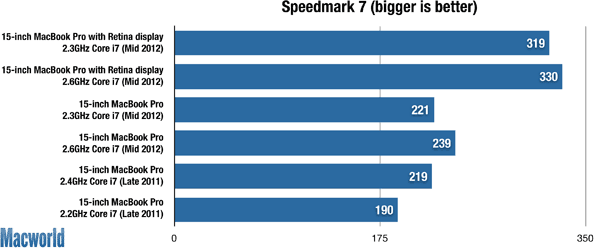
The 2.6 GHz Retina MacBook Pro is the fastest Mac Macworld Labs has
ever tested.
On the upside, in Macworld Lab testing of the Retina MacBook Pro
models using Speedmark 7 determined that the 2.6 GHz Core i7 Retina
MacBook Pro isn't just the fastest laptop they've tested, but the
fastest Mac they've tested - a whopping 51% faster than last year's
high-end MacBook Pro.
Link: MacBook Pro with
Retina Display Redefines the Concept of a 'Pro' Laptop
MacBook Pro with Retina Display: Over-Engineered
and Over-Priced
Mac 360's Jack D. Miller says the new MacBook Pro with Retina
Display is the most over-engineered personal computer ever, deeming it
simply too much engineering with too much quality. Using automotive
analogies, Miller asks, "can the average Mac user afford a Mac these
days? Sure, all models are selling well. So are BMWs, Lexus, Cadillacs,
and other luxury brands."
However, he says his concern with this new Mac is that Apple has
gone beyond affordable luxury and into the rarefied atmosphere of Rolls
Royce, Lamborghini, Maserati, et al, noting that while iFixit
called the latest MacBook Pro with Retina Display an engineering
marvel, they also gave it their lowest repairability score ever based
on their teardown, concluding that with the new MacBook line Apple is
reverting to a bygone era whereby only a privileged few can afford all
the engineering and design baked into a new Mac. Like a luxury car, he
says, the new MacBook Pro with Retina Display is drool-worthy, but the
quality of engineering and components make it a luxury bauble not fit
for the masses.
Link: The MacBook Pro
with Retina Display Is the Most Over Engineered Personal Computer
Ever
Retina MacBook Pro: Unfixable, Unhackable,
Untenable
In a company blog, iFixit CEO Kyle Wiens observes, "Apple is asking
users to define the future of the MacBook Pro . . . Once
again . . . Apple has presented the market with a choice.
They have two professional laptops: one that is serviceable and
upgradeable, and one that is not." Concluding after a teardown that the
Retina MacBook Pro is "least-repairable laptop we've taken apart" and
that "We have consistently voted for hardware that's thinner rather
than upgradeable . . . But we have to draw a line in the sand
somewhere. Our purchasing decisions are telling Apple that we're happy
to buy computers and watch them die on schedule . . . Every
time we buy a locked down product containing a non-replaceable battery
with a finite cycle count, we're voicing our opinion on how long our
things should last."
Wiens says that beginning with the original 2008 MacBook Air, Apple
sacrificed performance and upgradeability to achieve a thinner form
factor, with RAM soldered to the logic board - meaning that a
heretofore simple memory upgrade would now involve a prohibitively
expensive replacement of the entire board - and a non-swappable
battery.
Did we want a machine that would be stuck with 2 GB of RAM forever?
Would we support laptops that required replacement every year or two as
applications required more memory and batteries atrophied? Wiens notes
that consumers overwhelmingly voted yes, with Air sales soaring to take
40% of Apple's notebook sales by the end of 2010, buyers voting with
their wallets to purchased the device despite its built-in death
clock.
Link:
The New MacBook Pro: Unfixable, Unhackable, Untenable
Apple Charges $199 to Replace Retina MacBook Pro's
Battery
Computerworld's Gregg Keizer says the nonupgradeable battery and
other "Air-izing" traits of Apple's new Retina MacBook Pro has induced
a repair expert to say, "We have to draw a line in the sand."
Apple Retina MacBook Pro owners will pay more to replace the
notebook's integrated battery, which is literally glued to the case and
can't be replaced by the user but must be returned to Apple.
Keizer says Apple's price for replacing the Retina MacBook Pro's
battery is $199 - 54% higher than the $129 fee for swapping out a
MacBook Air battery.
Link: Apple Charges 54%
More to Replace Retina MacBook Pro's Battery
iFixit Goes Inside the MacBook Pro's Retina
Display
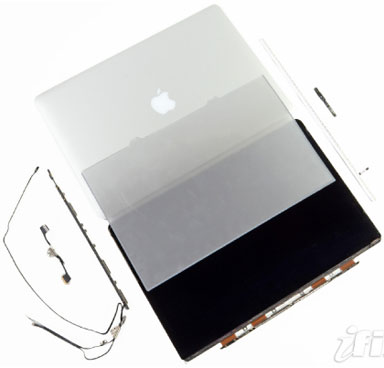 iFixit's Chief Information Architect Miroslav Djuric and his
team took a closer look at the component that makes the new model
MacBook Pro so technologically groundbreaking: the Retina Display.
Apple claims that the Retina display in the MacBook Pro is the most
stunning display to ever grace the lid of a notebook computer.
iFixit's Chief Information Architect Miroslav Djuric and his
team took a closer look at the component that makes the new model
MacBook Pro so technologically groundbreaking: the Retina Display.
Apple claims that the Retina display in the MacBook Pro is the most
stunning display to ever grace the lid of a notebook computer.
"Honestly, we agree," says Djuric. "The Retina display is an
engineering marvel. Its LCD is essentially the entire display assembly.
Rather than sandwich an LCD panel between a back case and a piece of
glass in front, Apple used the aluminum case itself as the frame for
the LCD panel and used the LCD as the front glass. They've managed to
pack five times as many pixels as the last model in a display that's
actually a fraction of a millimeter thinner. And since there's no front
glass, glare is much less of an issue."
But at what cost - the kind that's green and has dead presidents on
it? Unhappily, Djuric notes that here's no way to replace just the LCD,
since the entire thing is the LCD. Consequently, users who experience
unfortunate accidents will be obliged to replace the entire display
assembly. The intricacies of opening the display also mean that should
anything else fail internally, the whole assembly will still have to be
replaced or the user will have to make do without the component.
Teardown Highlights
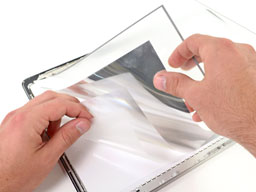 The Retina display is a hair
over 7 mm at its thickest point and just over 3 mm at its thinnest,
only a fraction of a millimeter thinner than the regular MacBook
Pro.
The Retina display is a hair
over 7 mm at its thickest point and just over 3 mm at its thinnest,
only a fraction of a millimeter thinner than the regular MacBook
Pro.- The display hinges have cables routed through them, without
any means to remove the cables. So instead of routing cables underneath
cable retainers (as in the non-Retina MacBook Pro), you just have to
replace the cables and hinges together.
- The FaceTime HD camera interfaces with the rest of the computer via
a Vimicro VC0358 USB camera interface IC.
- Underneath the top layer we find a series of films and sheets that
manipulate light before sending it to the user's eye.
- A strip of 48 LEDs at the bottom of the display assembly provides
all the light your Retina display needs.
- The bottom edge of the case has two features that iFixit's techs
thought were pretty neat: a laser engraved internal use code and a
nifty arrangement of round indentations.
Photos courtesy iFixit.
Link: MacBook Pro 15"
Retina Display Teardown
Link: MacBook Pro with Retina Display
Teardown
15" MacBook Pro News & Opinion
15" Mid 2012 MacBook Pro More Repairable,
Upgradeable, and Hackable Than Retina Model
iFixit's Chief Information Architect Miroslav Djuric observes that
while the new Retina display MacBook Pro is getting all the press
attention, Apple's upgraded holdover unibody MacBook Pro models are
still a formidable laptop option, and are way more repairable,
upgradeable, and hackable than their sleeker, 0.24"-thinner, one
pound-lighter sibling.
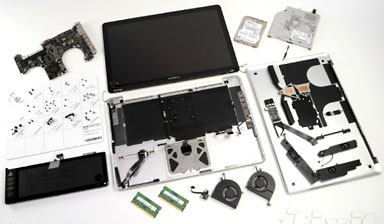 This isn't much of a surprise to anyone, and neither is the
very respectable 7/10 repairability score (compared to 1/10 for the
MacBook Pro with Retina Display). Internally, the machine is pretty
much the same as the last year's model, but with a nice speed bump from
Intel Ivy Bridge CPU silicon, Intel's HD Graphics 4000 IGPU, and, on
the 15" model, new Nvidia GeForce GT 650M discrete graphics with either
512 MB or 1 GB of video RAM and automatic graphics switching.
This isn't much of a surprise to anyone, and neither is the
very respectable 7/10 repairability score (compared to 1/10 for the
MacBook Pro with Retina Display). Internally, the machine is pretty
much the same as the last year's model, but with a nice speed bump from
Intel Ivy Bridge CPU silicon, Intel's HD Graphics 4000 IGPU, and, on
the 15" model, new Nvidia GeForce GT 650M discrete graphics with either
512 MB or 1 GB of video RAM and automatic graphics switching.
Djuric says that one question still nags at iFixit's tech staff - to
wit: "could Apple make a super-sleek laptop like the MacBook Pro with
Retina Display and still preserve the repairability of the
machine?"
The answer he says is "yes." But of course they didn't, alas.
iFixit's teardown comparison highlights the differences between the
two machines, with regular MacBook Pro is always cited first, compared
to the MacBook Pro with Retina Display noting:
- Use of regular vs. proprietary screws. This is a no-brainer in our
books - there's absolutely no benefit from using a proprietary
pentalobe screw type in any electronic device, aside from keeping users
out of it.
- The battery is exactly the same capacity as last year's model: 77.5
Wh at 10.95 V. It's the same size as well, a solid 13.8 mm in
thickness. The MacBook Pro with Retina Display's battery varies in
thickness from 5.25 mm to 8.60 mm depending on which cell you measure,
and it has a plastic frame around some of the cells. Although the
discrepancy is large between the two battery thicknesses, the Retina
MacBook Pro's battery (photo here: http://bit.ly/retina_battery) is
spread out over a much larger surface area. It would've taken some
engineering, but Apple could expand the frame in the Retina MacBook Pro
to encompass the whole battery, and allow it to come out as a singular,
non-glued unit.
 Here's a big difference: the regular MacBook
Pro 2.5" SATA hard drive is 9.45 mm thick, compared to 3.16 mm for the
SSD found in the Retina Display MacBook Pro. But the SSD is one of the
few things that is actually removable from the Retina version, and
Apple could use a nonproprietary mSATA connector so folks could
replace the SSD with an off-the-shelf unit.
Here's a big difference: the regular MacBook
Pro 2.5" SATA hard drive is 9.45 mm thick, compared to 3.16 mm for the
SSD found in the Retina Display MacBook Pro. But the SSD is one of the
few things that is actually removable from the Retina version, and
Apple could use a nonproprietary mSATA connector so folks could
replace the SSD with an off-the-shelf unit.- While the individual RAM modules are thin (~3.15 mm), the "stacked"
RAM slots in the regular MacBook Pro are a whopping 9.15 mm thick. Yet
the entire Retina MacBook Pro is only 18 mm thick, and allocating half
of that dimension to RAM slots would be a big sacrifice. But, an
individual RAM slot is only 4.27 mm thick; if the design of the logic
board featured the RAM slots side by side (like older MacBooks), folks
could still replace their RAM for years to come.
- While the regular MacBook Pro display may not be Retinalicious, a
cracked LCD will still be the most expensive repair (aside from the
logic board) on this machine. Thankfully, users can replace just the
LCD instead of the entire assembly. Incorporating a removable LCD into
the MacBook Pro with Retina Display would increase the thickness by
less than a millimeter, while still preserving the awesome Retina
resolution.
- We love the optical drive in the regular MacBook Pro because we
appreciate the additional space given by adding a second hard drive
(using one of iFixit's SATA enclosures: http://bit.ly/sata_enclosure). A
significant portion of the weight savings in the Retina MacBook Pro
comes from Apple's removal of the optical drive. While the lack of an
optical drive won't be major imposition for many, the inability to
inexpensively add a secondary, high capacity spinning drive is
definitely a significant loss in terms of upgradability. Removing the
optical drive photo at: http://guide-images.ifixit.net/igi/24bIZyMurBsxCPP2.huge
Photos courtesy iFixit.
Link: MacBook Pro 15"
Unibody Mid 2012 Teardown
Link: MacBook Pro with Retina Display
Teardown
13" MacBook Pro News & Opinion
13" MacBook Pro or 13" MacBook Air?
Ars Technica's Chris Foresman says that while the new 15" Retina
MacBook Pro has attracted the most attention this week, Apple also
refreshed its existing MacBook Air and MacBook Pro lines. He suggests
that if you're in the market for a 13" model, it may be a tough
decision to make between the Air or Pro, especially since prices for
both now start at $1199.
Foresman says Ars editors dug deep into the specs to analyze the
pros and cons for each model and came away convinced that that the
13" MacBook
Pro still has a lot to offer for the money, and that if you're
willing to lug around the extra pound-and-a-half, you'll have a machine
that's arguably a better value for the money with potential longevity
extended by future storage and RAM upgrade potential that are lacking
in the 13" MacBook
Air.
Link: Faceoff: 13"
MacBook Pro vs. 13" MacBook Air
Primate Labs Posts New 13" MacBook Pro
Benchmarks
Primate Labs says while Geekbench 2 results for most of last week's
new Macs were quickly uploaded to the Geekbench Browser, it took a
while for 13" MacBook Pro results to appear, but now that almost a week
has passed, hundreds of results for the 13" MacBook Pro have been
uploaded - the takeaway being that the latest 13" MacBook Pros offer a
nice increase in performance over the previous models, with both the
Core i5 and the Core i7 Mid 2012 13" MacBook Pros over 10% faster than
the equivalent Late 2011 13" MacBook
Pros - some of the increase attributable to higher processor
speeds, while some of the increase is from the improved Ivy Bridge
processor architecture.
The latest MacBook Pros also offer a nice increase in performance
over the latest MacBook Airs. The Core i5 13" MacBook Pro is 10% faster
than the Core i5 13" MacBook Air, while the Core i7 13" MacBook Pro is
15% faster (and $100 cheaper) than the Core i7 13" MacBook Air.
It's also noted that while the MacBook Air outsells the Core i5
MacBook Pro by a factor of two to one, the Core i7 MacBook Pro outsells
the Core i7 MacBook Air by the same factor, suggesting that users who
want the fastest 13" Mac laptop are opting for the MacBook Pro, while
everyone else is opting for the 13" MacBook Air.
Link: 13-inch MacBook
Pro Benchmarks
Rumor Roundup
13" Retina MacBook Pro Expected in October
AppleInsider's Neil Hughes reports that Apple will expand its
"RetinaBook" lineup to two models come October, according to KGI
Analyst Ming-Chi Kuo, who's been on something of a roll with Apple
product forecasts lately. Kuo, for example, accurately predicted this
week's new MacBook Pro release, that Apple would temporarily adopt a
three-family MacBook strategy, and the discontinuance of the 17"
MacBook Pro.
Hughes says that in a note on Thursday, Mr. Kuo affirmed his
expectation that Apple will be commencing production of a 13" version
of the Retina Display MacBook Pro in September in preparation for a
product launch in early October, strategic to the holiday shopping
season, falling within a traditional calendar slot for Apple notebook
upgrades and releases.
Mr. Kuo predicts that a 13" Retina Display MacBook Pro will boast a
panel resolution of 2560 by 1600 pixels, a slightly thinner section
than the 15" model at 18 millimeters, all flash/SSD storage,
hard-soldered RAM, Thunderbolt and USB 3 I/O, reliance on Intel's HD
4000 integrated graphics with no discrete graphics support, and Intel
Ivy Bridge Core i5 and i7 processors with a clock speeds greater than
2 GHz.
Link: Apple Expected to
Launch 13" Retina MacBook Pro by Early Oct.
Supply Chain Indications Point to 13" Retina
MacBook Pro in Fall
DisplaySearch's Richard Shim and Jeff Lin note that through their
panel supply chain research, they've been tracking 2880 x 1800
resolution panels since the Q1 edition of their large area report, and
recently noted Apple was the most likely PC brand to be requesting
them.
Following Apple's announcement last week, they have checked back
into the ODM supply chain, and found that yield issues pushed the start
of mass production into late May, with unit production expected to be
less than 2 million in calendar year 2012. Shim and Lin also note that
similar to the case of the New iPad,
the new Retina MacBook Pro doubles previous pixel density, which will
require more power consumption in the backlight, and that the new
MacBook Pro's battery pack is nearly 23% larger than that used in the
previous generation.
Shim and Lin also note that their Q1 report indicated that 13.3"
2560 x 1600 resolution panels were being prepared for production in the
third quarter, and say that ODM supply chain sources indicate that
Apple will use this panel in a smaller Retina MacBook Pro unit to be
launched in the Q4, 2012 with production volume expected to be roughly
twice that of the 15.4" Retina MacBook Pro, and as with the new
15.4-incher will have double pixel density of the respective preceding
MacBook Pro, the 13" version of which has a 1280 x 800 resolution.
Link: Supply Chain
Indications for the New MacBook Pro
Apple Updates
Apple Releases Thunderbolt Software Update 1.2.1
for Ethernet Support
Thunderbolt Software Update 1.2.1 adds support for the Apple
Thunderbolt to Gigabit Ethernet Adapter.
System Requirements: OS X Lion 10.7.4 or later
Link: Thunderbolt
Software Update 1.2.1
Tech Trends
Vizio's Ultrabooks: Real MacBook Air
Rivals?
PCWorld's Jared Newman notes that five months ago, Vizio impressed
him with a line of slick new laptops - the first PCs by the company
known best for its televisions, and that with its first Ultrabook PCs -
Vizio seems to have nailed the concept with machines built from a
single slab of aluminum (just like Apple's MacBooks) and featuring a
1600 x 900 panel for the 14" variant and a 1920 x 1080 Full HD display
for the 15" Vizio Ultrabook - not quite a Retina Display, but
close.
Other similarities to the MacBook Air include Intel Core i5 and Core
i7 processors (Vizio also offers a Core i3 model), 4 GB of RAM,
and 128 GB of solid state storage (although Apple's Airs can be
upgraded to 8 GB of RAM and up to 512 GB SSD capacity). Both
makers claim up to 7 hours of battery life, and both offer USB 3.0, but
Vizio uses HDMI output instead of Thunderbolt.
However, a major parting of the ways is in price. Vizio's 14"
Ultrabook starts at $900, and its $950 Core i5 model is $250 cheaper
than the closest equivalent 13" MacBook Air. The Vizio 15" version
starts at $950 with a Core i3 processor.
Link: Vizio's Ultrabook
PCs: Real MacBook Air Rivals, at Last?
Bargain 'Books
For deals on current and discontinued 'Books, see our 13" MacBook and MacBook Pro,
MacBook Air, 13" MacBook Pro, 15" MacBook Pro, 17" MacBook Pro, 12" PowerBook G4, 15" PowerBook G4, 17" PowerBook G4, titanium PowerBook G4,
iBook G4, PowerBook G3, and iBook G3 deals.
We also track iPad,
iPhone, iPod touch, iPod classic, iPod nano, and iPod shuffle deals.



 iFixit's Chief Information Architect Miroslav Djuric and his
team took a closer look at the component that makes the new model
MacBook Pro so technologically groundbreaking: the Retina Display.
Apple claims that the Retina display in the MacBook Pro is the most
stunning display to ever grace the lid of a notebook computer.
iFixit's Chief Information Architect Miroslav Djuric and his
team took a closer look at the component that makes the new model
MacBook Pro so technologically groundbreaking: the Retina Display.
Apple claims that the Retina display in the MacBook Pro is the most
stunning display to ever grace the lid of a notebook computer. The Retina display is a hair
over 7 mm at its thickest point and just over 3 mm at its thinnest,
only a fraction of a millimeter thinner than the regular MacBook
Pro.
The Retina display is a hair
over 7 mm at its thickest point and just over 3 mm at its thinnest,
only a fraction of a millimeter thinner than the regular MacBook
Pro. This isn't much of a surprise to anyone, and neither is the
very respectable 7/10 repairability score (compared to 1/10 for the
MacBook Pro with Retina Display). Internally, the machine is pretty
much the same as the last year's model, but with a nice speed bump from
Intel Ivy Bridge CPU silicon, Intel's HD Graphics 4000 IGPU, and, on
the 15" model, new Nvidia GeForce GT 650M discrete graphics with either
512 MB or 1 GB of video RAM and automatic graphics switching.
This isn't much of a surprise to anyone, and neither is the
very respectable 7/10 repairability score (compared to 1/10 for the
MacBook Pro with Retina Display). Internally, the machine is pretty
much the same as the last year's model, but with a nice speed bump from
Intel Ivy Bridge CPU silicon, Intel's HD Graphics 4000 IGPU, and, on
the 15" model, new Nvidia GeForce GT 650M discrete graphics with either
512 MB or 1 GB of video RAM and automatic graphics switching. Here's a big difference: the regular MacBook
Pro 2.5" SATA hard drive is 9.45 mm thick, compared to 3.16 mm for the
SSD found in the Retina Display MacBook Pro. But the SSD is one of the
few things that is actually removable from the Retina version, and
Apple could use a nonproprietary mSATA connector so folks could
replace the SSD with an off-the-shelf unit.
Here's a big difference: the regular MacBook
Pro 2.5" SATA hard drive is 9.45 mm thick, compared to 3.16 mm for the
SSD found in the Retina Display MacBook Pro. But the SSD is one of the
few things that is actually removable from the Retina version, and
Apple could use a nonproprietary mSATA connector so folks could
replace the SSD with an off-the-shelf unit.
